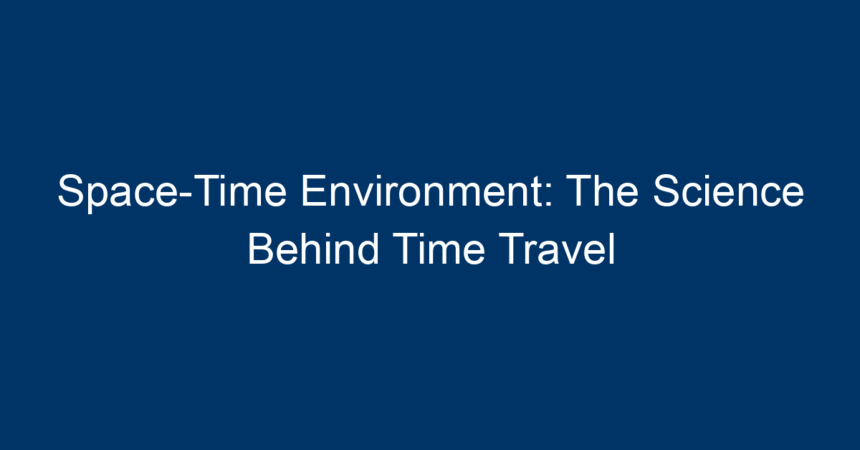Introduction
Time travel has captivated human imagination for centuries, inspiring countless books, movies, and theories. But what if we told you that the concept of time travel isn’t solely the realm of science fiction? At the heart of this intriguing idea lies the space-time environment, a fundamental aspect of modern physics that shapes our understanding of the universe. In this article, we will delve into the complexity of the space-time environment, unveiling the science behind time travel while exploring various theories and implications. Join us as we journey through time and space!
What is Space-Time?
The concept of space-time, introduced by Albert Einstein in the early 20th century, blends the three dimensions of space with the dimension of time into a single four-dimensional continuum. In this framework, events are located not just in three-dimensional space but also in time, fundamentally altering our perception of reality.
Understanding the Fabric of the Universe
Within the context of the space-time environment, objects with mass create distortions that affect the movement of other objects. Picture a stretched rubber sheet: placing a heavy ball in the center creates a dip that pulls smaller balls towards it. This analogy illustrates how gravity works in a curved space-time, where larger masses influence the trajectory of smaller masses.
Theoretical Foundations of Time Travel
Time travel might sound fantastic, but theoretical physics offers several models suggesting it could be possible under certain conditions. Here, we examine some of the most prominent theories surrounding time travel within the space-time environment.
Wormholes: Shortcuts through Space-Time
One of the most popular theoretical solutions to facilitate time travel is the concept of wormholes. These hypothetical passages through space-time could connect distant points in the universe or even different times.
How Wormholes Work
Imagine a piece of paper folded in half. If you draw two points on opposite edges, a wormhole would be the tunnel connecting these points, allowing for instant travel between them. In theory, if we could stabilize a wormhole (which currently remains in the realm of speculation), it could allow an individual to leap into the past or future.
Time Dilation: The Effects of Speed and Gravity
Another fascinating aspect of the space-time environment is time dilation, a phenomenon predicted by Einstein’s theory of relativity.
The Twin Paradox
Consider a scenario known as the twin paradox: one twin embarks on a journey through space at near-light speed while the other remains on Earth. Due to time dilation, the traveling twin would age more slowly. Upon returning, they would find that they have aged less than their Earth-bound sibling, illustrating how relative motion affects the passage of time.
Closed Timelike Curves (CTCs)
Closed timelike curves are another theoretical concept suggesting the possibility of time travel. In simpler terms, CTCs allow an object to return to its own past by following a specific path through space-time.
Implications of CTCs
If CTCs exist, they challenge our intuitive understanding of causality. Events could potentially loop back on themselves, creating paradoxes and prompting questions about free will and determinism.
Current State of Time Travel Research
While the concept of time travel is largely speculative, scientific inquiry into the space-time environment continues to advance. Various studies and experiments are working towards understanding the fundamental principles that could one day make time travel a reality.
Quantum Mechanics and Time
The field of quantum mechanics introduces concepts that further complicate our understanding of time. The behavior of particles at the quantum level often defies classical logic, enabling phenomena like entanglement and superposition that could hint at new ways to perceive time.
Seeking Experimental Evidence
Researchers are exploring whether phenomena like black holes could lead to insights about time travel. Some theorists hypothesize that the extreme gravitational forces present in black holes may create conditions favorable for wormholes or CTCs, thus bridging the gap between theory and tangible proof.
The Philosophical Implications of Time Travel
As we explore the space-time environment and the theories of time travel, we must also consider the philosophical ramifications of such advancements.
Causality and the Butterfly Effect
One of the most profound implications of time travel is its relationship with causality. If one could go back in time and alter an event, the ramifications could create a butterfly effect—small changes leading to massive consequences. This raises questions about fate, determinism, and the potential for paradoxes in the timeline.
Ethical Considerations
Beyond the theoretical, time travel poses ethical dilemmas. If time travel were possible, should we change historical events? Would it be ethical to intervene in our past, knowing that it could significantly alter the present or future?
Conclusion: The Journey Ahead
While the idea of traversing the space-time environment remains largely theoretical, the pursuit of understanding time travel continues to inspire scientists, philosophers, and dreamers alike. As we develop new technologies and uncover the complexities of quantum mechanics and gravitational theories, who knows what revelations await us?
Actionable Insights
-
Stay Informed: Follow reputable scientific journals and publications that cover advancements in quantum physics and theories of time travel.
-
Explore Literature: Engage with both fictional and non-fictional works on time travel to gain a broader perspective on its implications.
-
Encourage Discussion: Join community forums or discussion groups interested in physics, philosophy, and science fiction to foster engaging conversations about the mysteries of time.
- Consider the Ethics: Reflect on the ethical implications of time travel and discuss these thoughts with peers to deepen your understanding of its complexities.
As we stand on the precipice of discovery within the enigmatic space-time environment, the quest for knowledge continues, reminding us that the boundaries of our understanding may be more flexible than we imagine.




